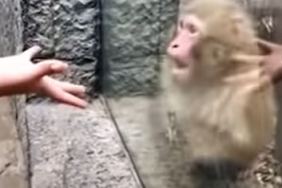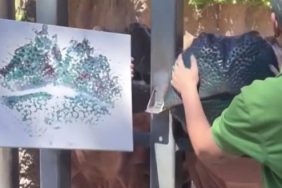Photo: Animal keeper Lesley Kirchner shows female orangutans Conny and Sinta videos of male orangutans in the original experiment conducted at Wilhelma Zoo, Stuttgart, Germany. Photograph: Wilhelma Zoo/Harald Knitter.
The Apenheul Primate Park in Apeldoorn, Netherlands, has just unveiled “Tinder for orangutans,” a four-year experiment to help increase mating in captivity. 11-year-old Samboja is the first female to participate in the project and is being shown photographs of possible male partners on a touchscreen from as far away as Singapore.
Also: 5 Animals We’d Like to See “De-Extincted”
Tinder, the dating app that allows users to select potential dating partners based on a selection of photographs, is based on the premise that much of our selection process is based on visual cues. High primates including orangutans, gorillas, chimpanzees, and bonobos, have been shown to have the same visual literacy as human beings, able to recognize photographs as two dimensional representations of the three dimensional world.

Orangutan at Apenheul Primate Park, courtesy of Twitter
Thus, it’s only natural for zookeepers to fuse technology and visual literacy to help increase the population of this endangered species. There are approximately 50,000 orangutans left in the wild (down from 230K just a century ago, due to the destruction of their habitat for logging and palm oil plantations over the past four decades).
The experiment is an effort to better understand the complex nature of orangutan mating, as they have very little idea how it works. Last December, The Guardian reported that 34-year-old captive Sumatran orangutan Karta at the Adelaide Zoo in Australia became pregnant after being put on contraceptives.
The idea of using technology to aid the mating process originates with a study done at the Wilhelma Zoo in Stuttgart, Germany, and the findings were publicly announced in February 2016. The coordinator of the European Endangered Species Programs (EEP) had picked potential mates for the females according to zoological criteria like age, character, and genetic diversity. The organizers then asked the zoos where the males lived to send videos that could be shown to the female orangutans in order to determine their interest level.

Orangutan at Apenheul Primate Park, courtesy of Twitter
According to The Washington Post, Sinta, the orangutan pictured in the header on the right, took a liking to Gempa, a male from a Belgian zoo. In turn, Gempa was shown video of Sinta and found her appealing. A “date” was arranged in Belgium, but no offspring resulted from the meeting.
Back at the Apenheul Primate Park, Thomas Bionda, a behavioral biologist, told Dutch broadcaster NOS, that they decided to introduce their “Tinder”-style experiment in an effort to increase the success of the mating opportunities they were setting up. “Often, animals have to be taken back to the zoo they came from without mating. Things don’t always go well when a male and female first meet.”
Naturally, if there’s no chemistry, it’s going to be a dud. By giving the females the chance to review their options and make selections in advance, the zookeepers hope that this will increase the chance of making a love connection. Bionda observed, “This is completely digital, of course. Usually smell plays an important role too. But with the orangutans, it will be: what you see is what you get.”

Orangutan at Apenheul Primate Park, courtesy of Twitter
And, what’s more, there is nary a chance a catfish will be lurking in the pool of applicants.
Miss Rosen is a journalist covering art, photography, culture, and books. Her byline has appeared in L’Uomo Vogue, Whitewall, Dazed Digital, Jocks and Nerds, and L’Oeil de la Photographie. Follow her on Twitter @Miss_Rosen.








